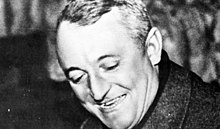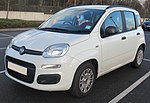Alfa Romeo Pomigliano d'Arco plant

The Alfa Romeo Pomigliano d'Arco plant, commonly called simply Stellantis Pomigliano, is an automotive assembly plant now owned by Stellantis, officially known as the Giambattista Vico Plant since 2008, in memory of the Neapolitan philosopher.[1] The plant, originally designed and constructed in 1968 by Alfa Romeo, is located largely in the town of Pomigliano d'Arco, and partially in the town of Acerra, employing roughly 6,000.
Production began in 1972, and Alfa Romeo production ended with the Alfa Romeo 159 in October 2011, restarting in 2022 with the Tonale.[2] The factory began assembling the current generation Fiat Panda in 2011.[3]
History
The first plant

In 1938 the Istituto per la Ricostruzione Industriale commissioned Alfa Romeo to build a large plant for the production of aircraft engines coupled with a small airport.
The choice fell on Pomigliano d'Arco, and thanks to the work of the engineer Ugo Gobbato it gave birth to a technologically advanced Aeronautical Center, able to produce engines for the technologically advanced era. The industrial complex completed just before the outbreak of World War II was one of the largest and most modern in Europe. To improve the living conditions of employees, residents in the area, there was built from scratch an entire neighborhood with about six hundred homes[4] each of which had a small garden, while a 700 person hotel was built for visitors.
- See Alfa Romeo Avio
In 1942 began series production of Daimler engines, the most commonly used by German companies. In 1943 the complex was completed with two other aerospace centers of production, for "complete structures" and "light alloys". Shortly after, two bombs destroyed the cities along the Alfa Romeo factory.
Reconstruction
The production of aircraft engines did not start until 1952, when the reconstruction and establishment of the city was done.
Meanwhile, Finmeccanica had founded, in part of the Aeronautical Center, the Officine di Costruzioni Aeronautiche e Ferroviarie Aerfer. Initially there was produced railway vehicles and trolleybuses then the '"Aerfer" also worked on commission for the production of parts for fighter jets for the Air Force and NATO. Just the experience of construction of these parts, since the second half of the fifties, the Pomigliano began to be based development and construction of new prototypes for fighter aircraft, whose projects were financially supported by the United States.
The Renault Dauphine was manufactured under license at the Pomigliano d'Arco plant as well as at Portello, Milan from 1959 to 1964 by Alfa Romeo and marketed as the Dauphine Alfa Romeo. It featured a Magneti-Marelli 12 volt electrical system, rather than 6 volt in the French model, and carried "Dauphine Alfa Romeo" or "Ondine Alfa Romeo" logos. Fiat, Alfa Romeo's main competitor in the home market, successfully lobbied to have taxation classifications based on overall length rather than engine displacement, successfully damping Dauphine sales.[5]
The birth of the Alfasud
At the end of the sixties Alfa Romeo had two factories in Italy: the first built in 1910 in Portello, a suburb of Milan, the second was the Alfa Romeo factory in Arese opened in 1963, in the province of Milan. In this period the Italian Government, the owner of IRI and then of Alfa Romeo decided to implement some measures to encourage the development of southern Italy and stem the emigration of many young people who moved to the north in search of work. So, with the opposition of the then President of Alfa Giuseppe Luraghi, it financed the construction of a new factory for the production of cars next to the existing facility "Alfa Romeo Avio" Pomigliano d'Arco. Thus was born the great project called "Alfasud".

The plant for car manufacturing was made very quickly. In 1967 was started the design of the plant and the new car model (the ' Alfasud ), both under the technical responsibility by engineer Rudolf Hruska, one of the most important engineers of the era, former "right hand" of Ferdinand Porsche and consultant to Fiat, Simca and Abarth.
The management of the operation, led by Hruska, was made completely independent by creating Alfasud S.p.A., based in Pomigliano d'Arco, which operated in the establishment and completion of the design of the new model, in a formally independent from the so-called "Alfanord" in Arese.
On 15 January 1968, after dozens of projects proposed and discussed, the general plan was submitted on for building the plant Alfasud Pomigliano d'Arco, which included the construction of new plants and beginning production in January 1972 .
The 'Construction Industry Neapolitan Vehicles Alfa Romeo - Alfasud S.p.A. was born on 17 January 1968 with shareholders Alfa Romeo (88%), Finmeccanica (10%) and IRI (2%). For the project were allocated just over 300 billion lire largely funded by the Cassa per il Mezzogiorno and Banco di Napoli.
The laying of the cornerstone took place on 28 April 1968, in the presence of Prime Minister Aldo Moro.
Despite several delays, due to the many strikes by organized workers, Hruska was able to complete the work and begin production, with only three months late, in April 1972 .
From the 1980s to today
In 1982 the ' Alfasud S.p.A. changed its name to "INCA Investments".
In 1986, Finmeccanica was forced to sell Alfa Romeo shares to Fiat for financial reasons and therefore the plant became part of Fiat Group.
Under new management, following the merger between Lancia and Alfa Romeo, the factory was renamed "Plant Alfa-Lancia Pomigliano d'Arco".
Following the corporate restructuring of 2007 the Fiat Group auto business become Fiat Group Automobiles S.p.A., Alfa turned into Alfa Romeo Automobiles S.p.A. as a result, in 2008, the factory was renamed to "Fiat Group Automobiles - Giambattista Vico plant."
On July 19 of 2010 Fiat sells ownership of the factory and its workers' contractual relationship to the subsidiary factory Pomigliano Italy.
The first car
The first car produced at the plant, was the Alfasud. It was the first front wheel drive Alfa Romeo production car, until then all the cars produced by Alfa were rear-wheel drive. The Alfasud was presented in 1971 at the Turin Motor Show. It was a hatchback with a tail fastback four-door (tailgate came only in 1982 ). The commercialization of the first series gave enormous fruits, because sales in those years amounted to about seventy thousand vehicles.
List of cars produced to date
| Image | Brand | Model | Production start | Production end | Production number |
|---|---|---|---|---|---|

|
Alfa Romeo | Alfasud (first serie) | 1972 | 1980 | 642,528 |

|
Alfa Romeo | Alfasud Giardinetta | 1975 | 1980 | 5,097 |

|
Alfa Romeo | Alfasud Sprint | 1976 | 1988 | 121,184 |

|
Alfa Romeo | Alfasud (second serie) | 1980 | 1984 | 203,904 |

|
Alfa Romeo | 33 (first serie) | 1983 | 1990 | 989,324 (1983–1995) |

|
Alfa Romeo | Arna (only mechanics) | 1983 | 1987 | 53,344 |

|
Alfa Romeo | 33 Sportwagon (first serie) | 1984 | 1990 | |

|
Fiat | Fiat Tipo | 1989 | 1990[2] | |

|
Autobianchi | Autobianchi Y10 | 1987 | 1995[2] | |

|
Alfa Romeo | 33 (second serie) | 1990 | 1994 | |

|
Alfa Romeo | 33 Sportwagon (second serie) | 1990 | 1994 | |

|
Alfa Romeo | 155 | 1992 | 1997 | 191,949 |

|
Alfa Romeo | 145 | 1994 | 2000 | 221,037 |

|
Alfa Romeo | 146 | 1995 | 2000 | 233,295 |

|
Alfa Romeo | 156 (first serie) | 1997 | 2003 | 331,877 |

|
Alfa Romeo | 156 Sportwagon (first serie) | 2000 | 2003 | 36,220 |

|
Alfa Romeo | 147 (first serie) | 2000 | 2004 | 580,000 (both series) |

|
Alfa Romeo | 156 (second serie) | 2003 | 2005 | 312,000 (incl. SW) |

|
Alfa Romeo | 156 Sportwagon (second serie) | 2003 | 2005 | |

|
Alfa Romeo | GT | 2003 | 2010 | 80,832 |

|
Alfa Romeo | 147 (second serie) | 2004 | 2010 | |

|
Alfa Romeo | 159 | 2005 | 2011 | 240,000 (incl. SW) |

|
Alfa Romeo | 159 Sportwagon | 2006 | 2011 |
Current cars produced
| Image | Brand | Model | Production start | Production end | Production number |
|---|---|---|---|---|---|

|
Fiat | Panda[broken anchor] | 2011 | present | |

|
Alfa Romeo | Tonale | 2022 | present | |

|
Dodge | Hornet | 2022 | present |
40°55′36″N 14°24′05″E / 40.926756°N 14.401279°E
References
- ^ "Fiat, il cambiamento e Giambattista Vico". archivio.denaro.it (in Italian). Archived from the original on 2014-03-13. Retrieved 2011-09-03.
- ^ a b c "Fiat di Pomigliano: riapre la fabbrica, ma a ottobre addio all'Alfa". metropolisweb.it (in Italian). Archived from the original on 2017-04-22. Retrieved 2011-09-04.
- ^ "La nuova Fiat Panda ora è Made in Italy". omniauto.it (in Italian). Retrieved 2011-09-04.
- ^ Alan Guido Mantoan. "Alfa Romeo in Southern Italy (1938-1943)" (PDF). gla.ac.uk. Archived from the original (PDF) on 2012-09-27. Retrieved 2011-09-04.
- ^ O'Callaghan, Daniel (July 31, 2023). "If you don't Make It, then Fake It (Part Two)". Driventowrite.com.
